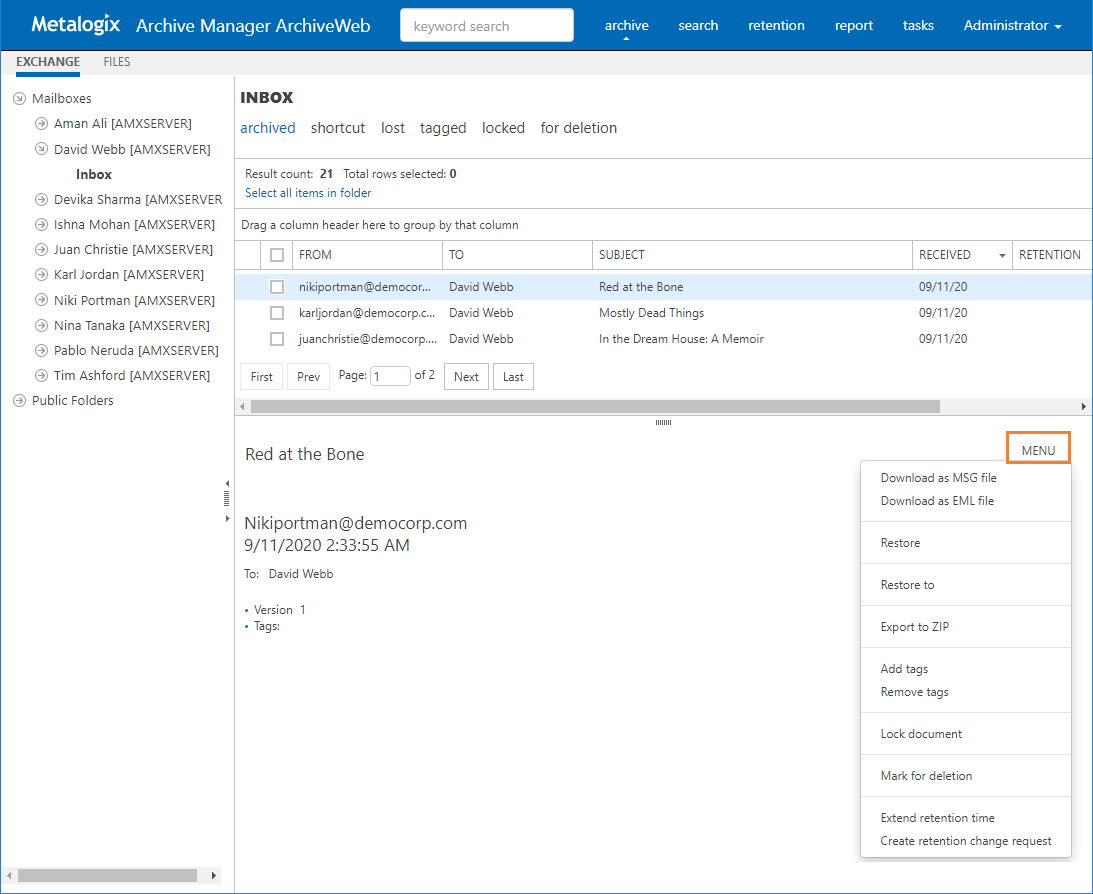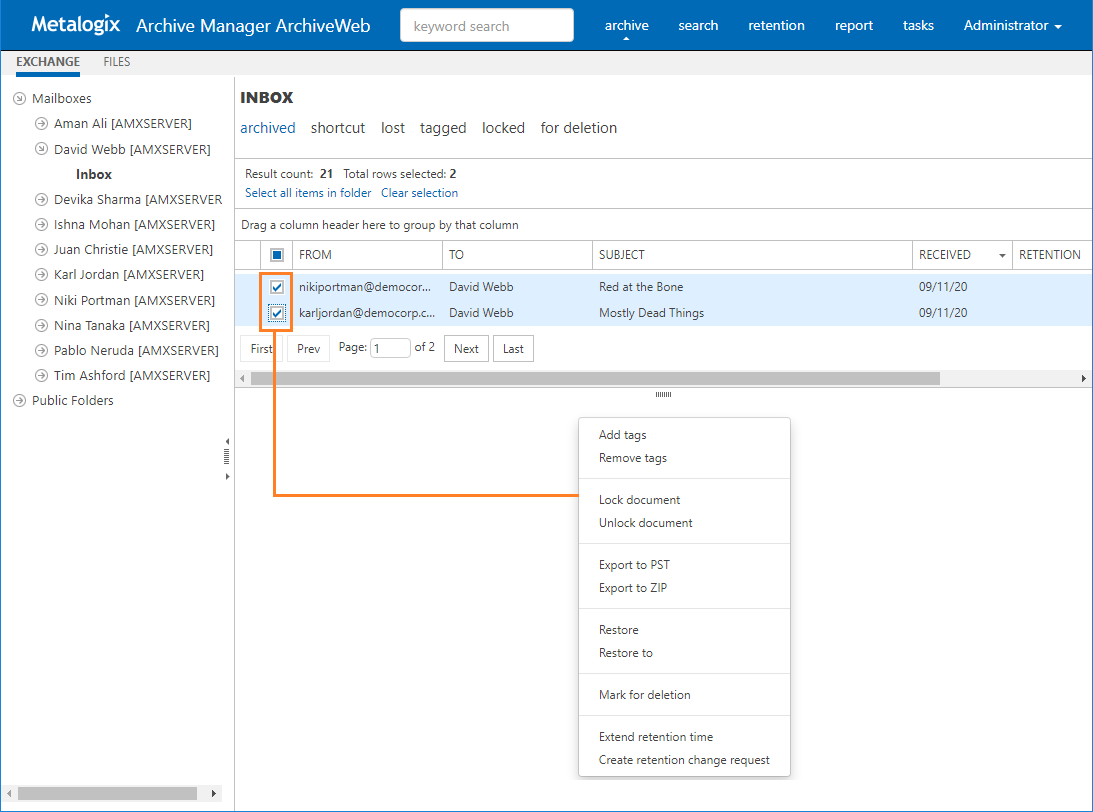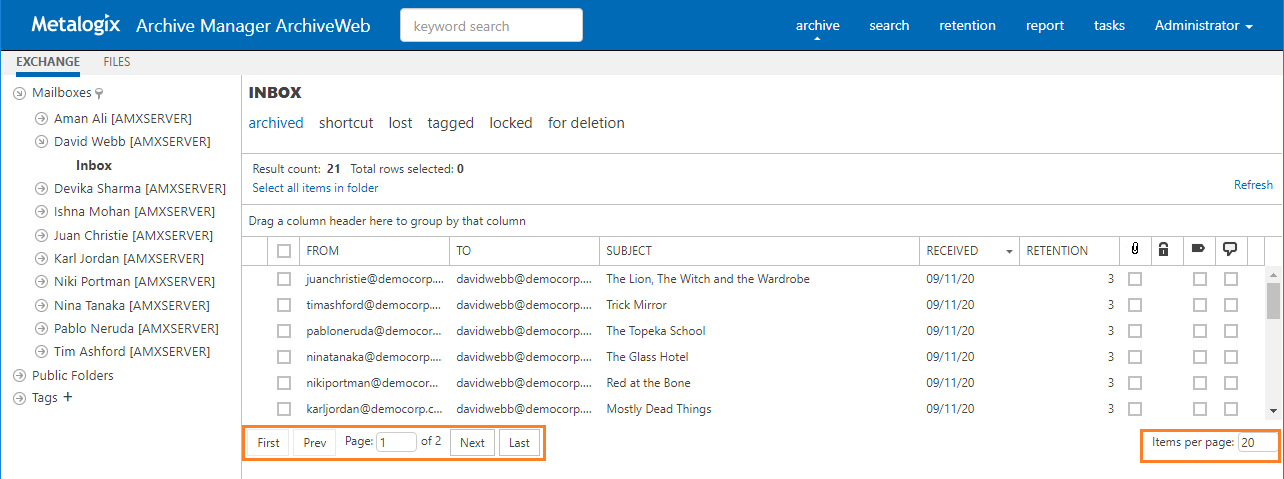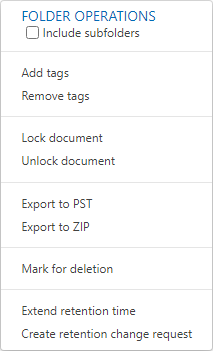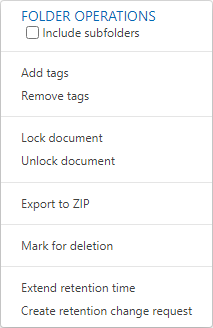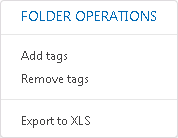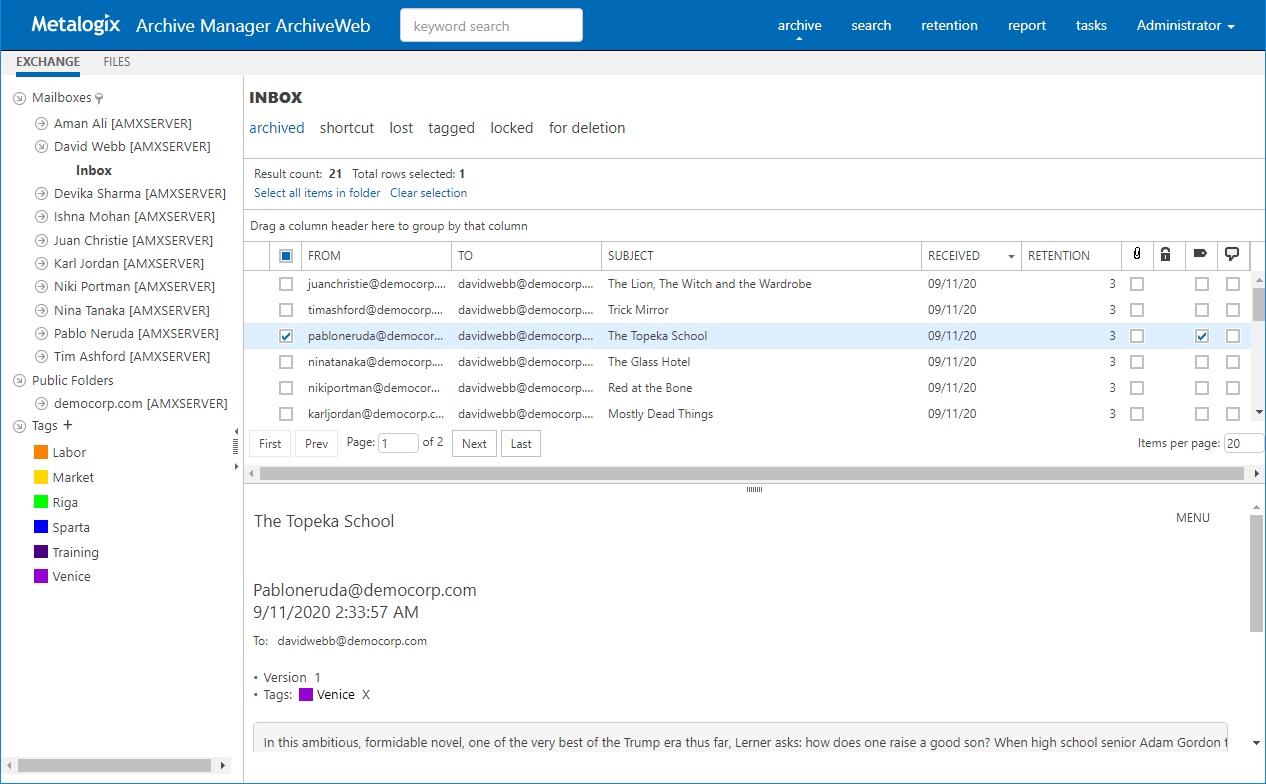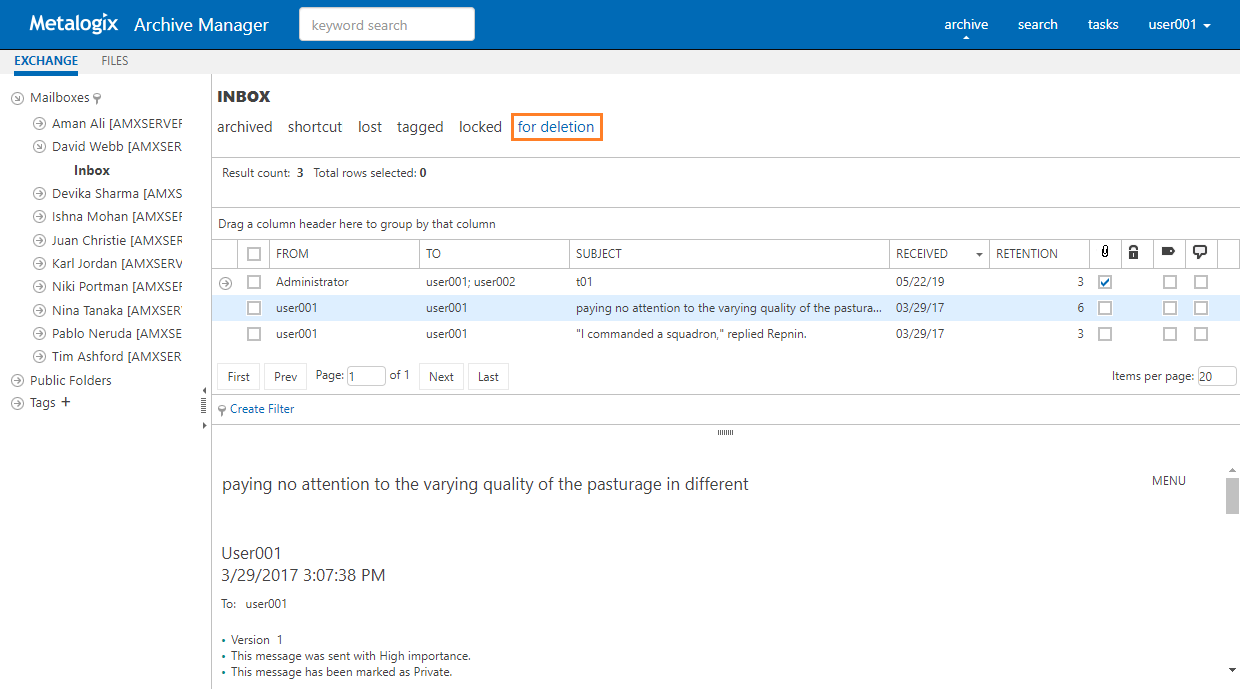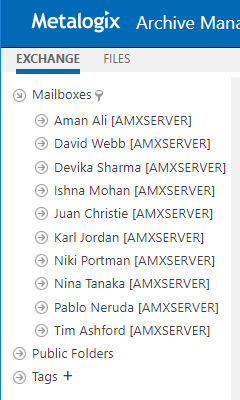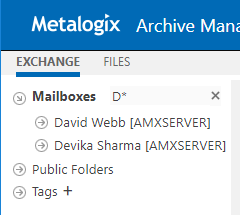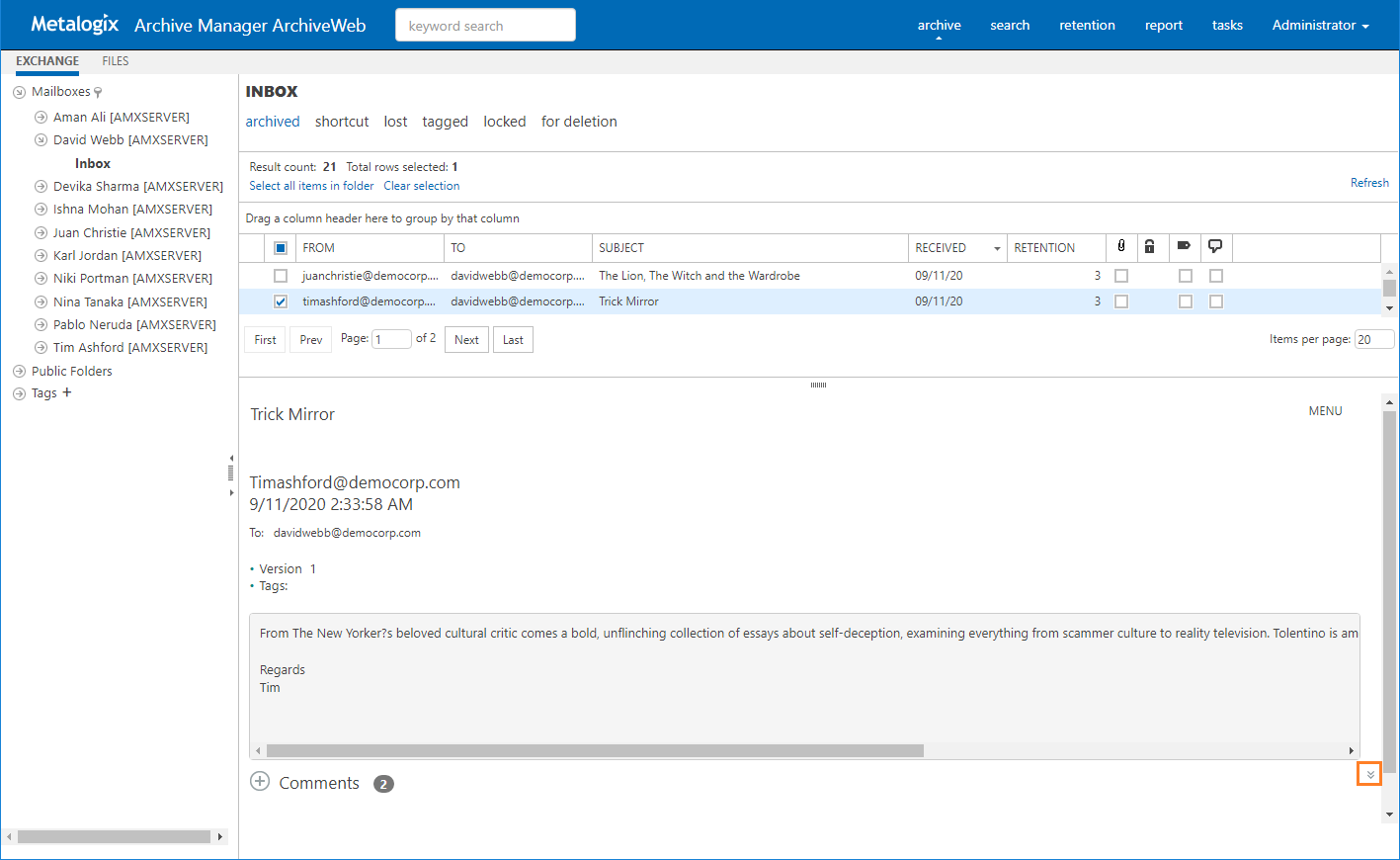List view conventions
With advanced list view functionality provided with every ArchiveWeb list view you can easily search even in huge lists of items and adjust the list to your specific needs. List view functions are the same as for all ArchiveWeb lists. In the main pane you can switch between these types of items by clicking on the respective filter:
·archived - all folder archived items except items marked for deletion
·shortcut - archive items with shortcut in mailbox
·lost - archived items with no reference in mailbox/file system
·tagged - archived items with tag(s)
·locked - locked archived items
·for deletion - archived items that are marked for deletion, i.e. they will be deleted when their retention period expires (and delete job runs)
Preview (if available) of any item you click on appears below the list view. To open More actions menu for the item click the More actions link (MENU) on the right bottom below the list.
Pop-up preview feature is also available for Exchange, Files, Auditing and Search results items. When a user double-clicks anywhere in the item's line, the item opens in pop/up window full screen mode with all functionality as in normal view, such as multi/action menu (MENU), and comments area.
checkboxes are designed for multi-select. If MORE THAN ONE item is selected, More actions menu appears automatically below the list.
Batch selection/unselection of items is done by clicking the Select all rows (Select all items in folder)/Clear selection action links just above the list. When Select all rows/Select all items in folder action links are selected, operations are performed over all items in the given folder. (See more under "Simple Grid" section.)
It is also possible to change the column order by simple drag-and-drop action. Individual columns can be shown or hidden - these settings are managed in user profile after clicking <UserName> / Manage Settings / Profile in Columns section.
Further, lists can be:
|
Øsorted |
Change the column sorting order by selecting the given column header and clicking its down/up arrow on the right (in case the arrow is not visible adjust the width of the column by dragging the line) |
|
Øgrouped |
Group table data by any column. To do so, drag the column header to the bar right above the table. Generated groups can be expanded by clicking the arrows next to them. As usual, the sorting order can be changed by clicking the little arrow in the dragged column header NOTE: In case of SIMPLE grid (see the Profile settings section) Grouping apply just for items on the current page. |
Simple Grid
Simple Grid is specific type of grid available for Archive\Exchange, Archive\Files and Report\Auditing list view. It allows customization of the list view and offers some specific features for handling the list items as described further. Simple Grid option can be set under <Logged-on User> / Manage settings / Profile / Settings. When you select Use grid view / Simple option for the list view (e.g. for Exchange/Archive list view), the given list view will have page navigation controls and will allow user to set number of items to be displayed per page (Items per page) as shown in the screenshot below.
Asynchronous folder operations over folder are available for Simple Grid. Click the Select all items in folder link to perform operation over all items in a specified folder.
NOTE: The link does not appear on filter tabs such as shortcut, lost, tagged, locked and for deletion.
When a user clicks on the Select all items in folder link, the Total rows selected label will show the same number as Result count label shows. No item will be selected (see picture below).
Additionally, the preview pane displays folder operations menu (according to user permissions) except Restore functions. (Restore operations are not allowed as folder operations.)
|
Exchange |
Files |
Audit |
|
|
|
|
By selecting any operation from FOLDER OPERATIONS action menu, a confirmation dialog appears:
Only when a user confirms this dialog the operation will be added to the Task list queue. The Task list is regularly checked for new tasks. When task arrives and no other is running, the given task will be run. Otherwise the task will wait in a queue.
NOTE: Only one task can be performed at a time.
Archive
This tab is displayed in ArchiveWeb navigation pane if Archive Manager for Exchange is installed in the environment. Under this tab you can handle emails archived by Archive Manager for Exchange. The Archive Manager archive is accessible even if the Exchange server is down. User can browse through emails, search in them, restore lost items etc. After clicking the Archive from the main bar and then Exchange form the grey sub-bar the Exchange Archive menu is unfolded on the left. It offers access to
oMailboxes
oPublic Folders
In our example we have logged in as an Administrator. Therefore, under the Mailboxes node you may see the Administrator folder. Providing that the administrator has rights to view other users mailboxes; these mailboxes can be listed under the Mailboxes node.
Unfolding the Administrator node displays all directories where emails have been archived (i.e. emails residing in these directories have been archived with Archive Manager for Exchange and are now placed in the archive).
NOTE: Not all Exchange tab functions may be available for the logged-on user. The functions must be allowed for the user. For more information see the Roles and Permissions sections.
Mailboxes node
The Mailboxes node can be expanded to view your mailbox sub-nodes. You can also see mailboxes of other users if you have been has been granted access rights in the Archive Manager Administration Center .
You can expand each mailbox to access the folders in the mailbox that contain archived emails. The content of the folder selected in the left pane is displayed in the main pane of the window. The list can be filtered by categories as listed above the list view:
·archived all folder archived items except items marked for deletion
·shortcut archived items with shortcuts in the mailbox are visible
·lost items that were archived but later deleted from the Exchange server are visible; these LOST ITEMS are not accessible in the user mailbox any more
·tagged items marked with any tag are visible
·locked items that were locked are visible
·for deletion items that were marked for deletion are visible because they are still in the archive and may be also visible in the mailbox as usual. When their retention period elapses, they will be deleted (see Mark for deletion option in the More actions topic)
Filtering the Mailboxes node
1.When you have access rights to see a large number of mailboxes, you can use the mailbox filter to search for a subset of mailboxes as described below:
2.Click 
3.Enter the mailbox name or use the asterisk wildcard with a partial name to filter the mailboxes (for example, enter D* to filter all mailboxes that start with "D"). The search is case sensitive and the server name enclosed in square brackets is not included in the search.
4.Click Enter on you keyboard to get the filtered subset of mailboxes.
5.Click X to clear the filter.
For more list filtering options see the next section.
List view
With advanced list view functionality provided with every ArchiveWeb list view you can easily search even in huge lists of emails and adjust the list to your specific needs. A list can be:
·sorted by any column click the little arrow in the column header
·grouped by any column drag the column to the bar just above the list
·filtered click 
For more details see List view conventions
The following information are included directly in the list:
·From column sender of the message
·To column - recipient(s) of the message
·Subject - email subject
·Received - receive date
·Retention - archive retention (in months)
·Attachment status (
·Lock status (
·Tagged status (
·Commented status (
List columns can be managed (show/hide) in the Columns section of the user profile (click <UserName> / Manage settings / Profile / Settings).
When you select the email in the list, its properties (importance, versioning, attachments) and email body are displayed under the list view in the preview pane. Preview is available only for some file types, e.g. for. By clicking the attachments, they can be opened or downloaded.
In the Preview pane, it is possible to add comments to emails. Simply scroll down in the Preview pane. Click plus sign 

NOTE: Not all Exchange Archive tab functions may be available for the logged-on user. The functions must be allowed for the user. For more information see the Roles and Permissions sections.

